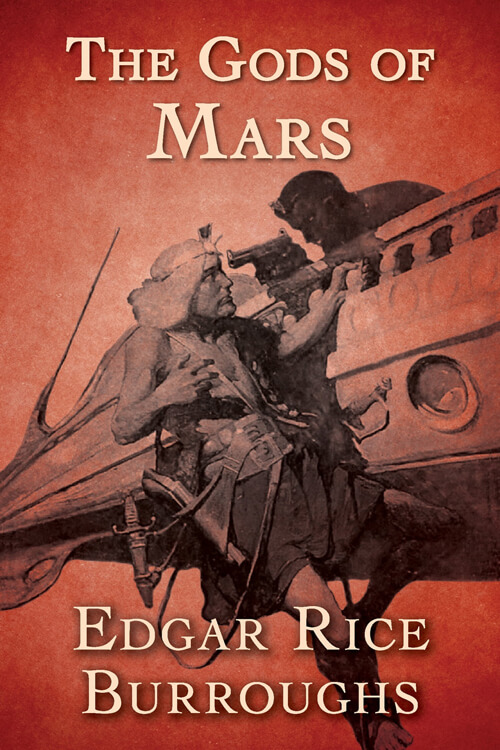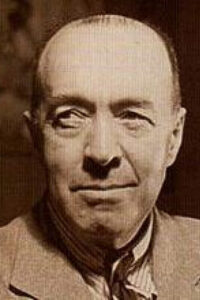
The Gods of Mars
Twelve years had passed since I had laid the body of my great-uncle, Captain John Carter, of Virginia, away from the sight of men in that strange mausoleum in the old cemetery at Richmond.
Often had I pondered on the odd instructions he had left me governing the construction of his mighty tomb, and especially those parts which directed that he be laid in an open casket and that the ponderous mechanism that controlled the bolts of the vault’s huge door be accessible only from the inside.
Twelve years had passed since I had read the remarkable manuscript of this remarkable man; this man who remembered no childhood and who could not even offer a vague guess as to his age; who was always young and yet who had dandled my grandfather’s great-grandfather upon his knee; this man who had spent ten years upon the planet Mars; who had fought for the green men of Barsoom and fought against them; who had fought for and against the red men and who had won the ever beautiful Dejah Thoris, Princess of Helium, for his wife, and for nearly ten years had been a prince of the house of Tardos Mors, Jeddak of Helium.
Twelve years had passed since his body had been found upon the bluff before his cottage overlooking the Hudson, and oft-times during these long years I had wondered if John Carter were dead, or if he again roamed the dead sea bottoms of that dying planet; if he had returned to Barsoom to find that he had opened the frowning portals of the mighty atmosphere plant in time to save the countless millions who were dying of asphyxiation on that far-gone day that had seen him hurtled ruthlessly through forty-eight million miles of space back to Earth once more. I had wondered if he had found his black-haired Princess and the slender son he had dreamed was with her in the royal gardens of Tardos Mors, awaiting his return.
Or, had he found that he had been too late, and thus gone back to a living death upon a dead world? Or was he dead after all, never to return either to his mother Earth or his beloved Mars?
Thus was I lost in useless speculation one sultry August evening when old Ben, my body servant, handed me a telegram. Tearing it open I read:
‘Meet me tomorrow at Hotel Raleigh Richmond.
‘JOHN CARTER’
Read or download Book
Edgar Rice Burroughs
Edgar Rice Burroughs (September 1, 1875 – March 19, 1950) was an American writer, best known for his prolific output in the adventure, science fiction, and fantasy genres. Best known for creating the characters Tarzan and John Carter, he also wrote the Pellucidar series, the Amtor series, and the Caspak trilogy. Tarzan was immediately popular, and Burroughs capitalized on it in every possible way, including a syndicated Tarzan comic strip, films, and merchandise. Tarzan remains one of the most successful fictional characters to this day and is a cultural icon. Burroughs’s California ranch is now the center of the Tarzana neighborhood in Los Angeles, named after the character. Burroughs was an explicit supporter of eugenics and scientific racism in both his fiction and nonfiction; Tarzan was meant to reflect these concepts.
Biography
Burroughs was born on September 1, 1875, in Chicago (he later lived for many years in the suburb of Oak Park), the fourth son of Major George Tyler Burroughs, a businessman, and Civil War veteran, and his wife, Mary Evaline (Zieger) Burroughs. His middle name is from his paternal grandmother, Mary Coleman Rice Burroughs. Burroughs was of almost entirely English ancestry, with a family line that had been in North America since the Colonial era. Through his Rice grandmother, Burroughs was descended from settler Edmund Rice, one of the English Puritans who moved to Massachusetts Bay Colony in the early 17th century. He once remarked: “I can trace my ancestry back to Deacon Edmund Rice.”
The Burroughs side of the family was also of English origin, having emigrated to Massachusetts around the same time. Many of his ancestors fought in the American Revolution. Some of his ancestors settled in Virginia during the colonial period, and Burroughs often emphasized his connection with that side of his family, seeing it as romantic and warlike. Burroughs was educated at several local schools. He then attended Phillips Academy, in Andover, Massachusetts, and then the Michigan Military Academy. Graduating in 1895, but failing the entrance exam for the United States Military Academy at West Point, he instead became an enlisted soldier with the 7th U.S. Cavalry in Fort Grant, Arizona Territory. After being diagnosed with a heart problem and thus ineligible to serve, he was discharged in 1897.
After his discharge, Burroughs worked at several different jobs. During the Chicago influenza epidemic of 1891, he spent half a year at his brother’s ranch on the Raft River in Idaho, as a cowboy, drifted somewhat afterward, then worked at his father’s Chicago battery factory in 1899, marrying his childhood sweetheart, Emma Hulbert (1876–1944), in January 1900. In 1903, Burroughs joined his brothers, Yale graduates George and Harry, who were, by then, prominent Pocatello area ranchers in southern Idaho, and partners in the Sweetser-Burroughs Mining Company, where he took on managing their ill-fated Snake River gold dredge, a classic bucket-line dredge. The Burroughs brothers were also the sixth cousins, once removed, of famed miner Kate Rice who, in 1914, became the first female prospector in the Canadian North. Journalist and publisher C. Allen Thorndike Rice was also his third cousin. When the new mine proved unsuccessful, the brothers secured for Burroughs a position with the Oregon Short Line Railroad in Salt Lake City. Burroughs resigned from the railroad in October 1904.
Later life
By 1911, around age 36, after seven years of low wages as a pencil-sharpener wholesaler, Burroughs began to write fiction. By this time, Emma and he had two children, Joan (1908–1972), and Hulbert (1909–1991). During this period, he had copious spare time and began reading pulp fiction magazines. In 1929, he recalled thinking that:
“[…] if people were paid for writing rot such as I read in some of those magazines, that I could write stories just as rotten. Although I had never written a story, I knew absolutely that I could write stories just as entertaining and probably a whole lot more so than any I chanced to read in those magazines.”
In 1913, Burroughs and Emma had their third and last child, John Coleman Burroughs (1913–1979), later known for his illustrations of his father’s books. In the 1920s, Burroughs became a pilot, purchased a Security Airster S-1, and encouraged his family to learn to fly. Daughter Joan married Tarzan film actor James Pierce. She starred with her husband as the voice of Jane, during 1932–1934 for the Tarzan radio series. Burroughs divorced Emma in 1934, and, in 1935, married the former actress Florence Gilbert Dearholt, who was the former wife of his friend (who was then himself remarrying), Ashton Dearholt, with whom he had co-founded Burroughs-Tarzan Enterprises while filming The New Adventures of Tarzan. Burroughs adopted the Dearholts’ two children. He and Florence divorced in 1942.
Burroughs was in his late 60s and was in Honolulu at the time of the Japanese attack on Pearl Harbor. Despite his age, he applied for and received permission to become a war correspondent, becoming one of the oldest U.S. war correspondents during World War II. This period of his life is mentioned in William Brinkley’s bestselling novel Don’t Go Near the Water.






